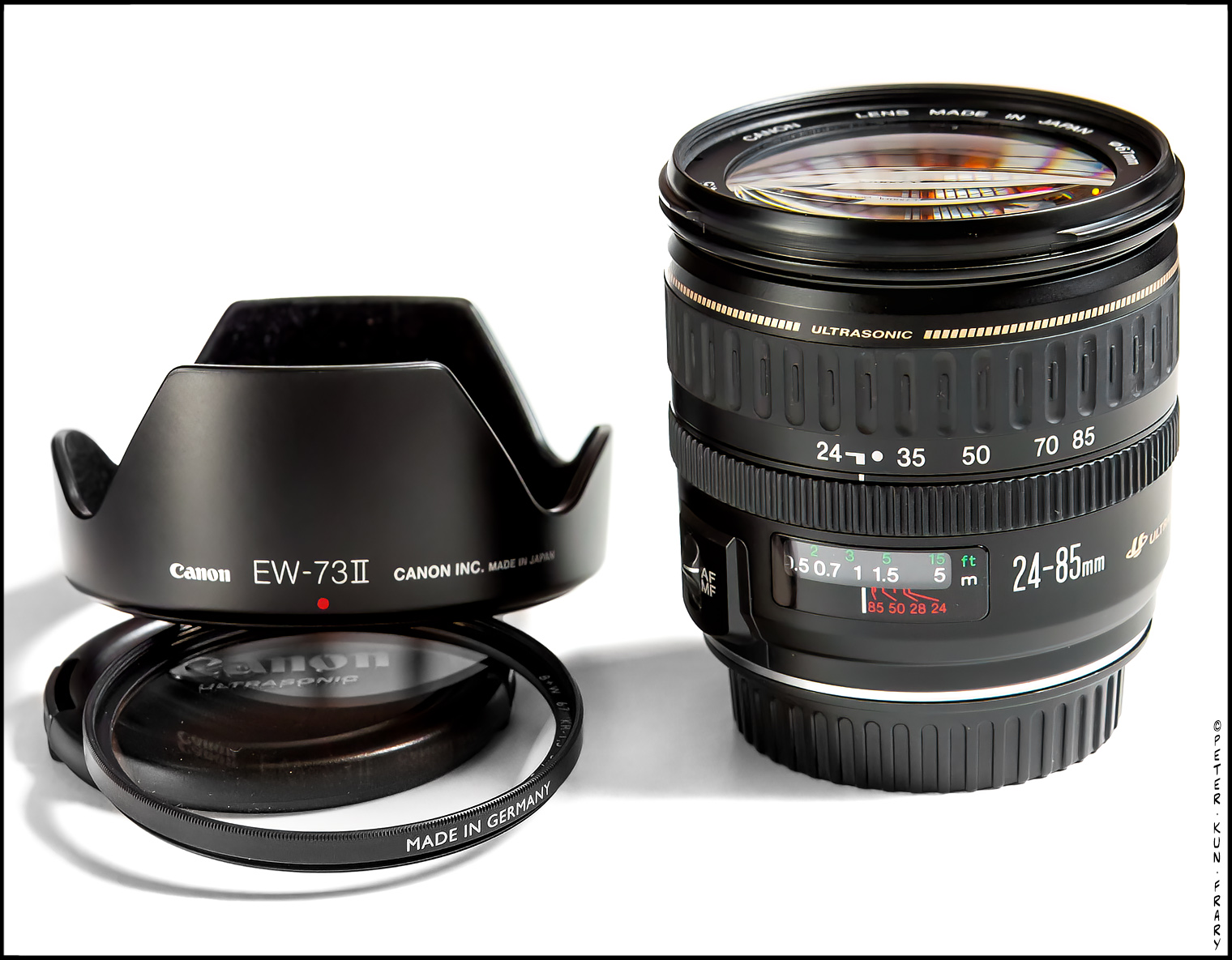.•
Canon
EF 24-85 3.5-4.5 USM
Tried and True Normal Zoom
Peter
Kun Frary
.
.
This zoom debuted in 1996 as the kit lens for the EOS IXE/IX (APS), and was popular into the new millennium. It was discontinued in 2009. In 1996, this lens was unique inasmuch as the range encompassed a true wide angle, 24 mm, to short telephoto, 85 mm. During the 1990s, most of Canon's normal coverage zooms started at 28 mm. Not too long before that, 35 mm was the norm.
Point Wilson WA | EOS 10D and EF 24-85 3.5-4.5 USM

This review consists of my opinions and observations as a hobbyist. No scientific measurements, MFT charts or pixel peeking comparisons will be found here.
 Compatibility Compatibility
This lens is compatible with all Canon EOS DSLR cameras. It also works on Canon R and M series mirrorless cameras with a mount adapter. It does not fit non-Canon cameras such as Pentax, Nikon, Fuji, etc.
 Construction Construction
Polycarbonate construction, but with a metal mount, keeps it a lightweight 380g (13.4 oz.). It's only a little bigger than an EF 50 1.4 USM. Most samples are black, but there's a silver special edition model sold with the 1996 EOS IX/IXE kit. Small size and optimal zoom range make it ideal for hiking and travel, especially for EOS film and full-frame DSLRs.
The twist-action zoom is smooth and doesn't creep. Zooming is accomplished by expanding and contracting two nested barrels. Like most AF lenses, the manual focus ring is tiny and not as smooth or finely pitched as manual lenses of yesteryear.
EF 24-85 3.5-4.5
USM | The Gothic
edition with EW-73
II hood.

This lens sports a 6-blade diaphragm. Thus, out-of-focus areas (bokeh) are reasonably smooth. A molded glass (GMo) aspherical lens element (4th) is used to correct astigmatism, achieve sharp definition, and to make the lens compact. Canon manages to pack 15 elements into a 69.5mm (L) x 73 mm (D) barrel! With all those elements, the optional petal hood, the EW-73II, should be used at all times to protect the front element and reduce flare.
The popular 67 mm filter size allows easy sharing of filters with other Canon lenses.
 Auto Focus Auto Focus
An internal lens
group is focused by ring-type USM (Ultrasonic
Motor). This motor dives the small rear elements
easily, resulting in fast AF. Thus,
the front element does not rotate nor does the
barrel expand or contract during focusing. Plus,
ring-type USM features full-time manual focusing
(FTM), allowing you to manually focus without
switching out of AF mode. Of course, being an
USM lens, it is silent during focus operation. If you
prefocus manually, the distance window in meters
and feet is useful.
Multnomah Creek | EOS 10D and EF 24-85 3.5-4.5 USM

 Image Quality Image Quality
For a consumer optic, the EF 24-85 3.5-4.5 USM delivers sharp and contrasty images. It's similar to the EF 28-105 3.5-4.5 USM, but slightly sharper at the wide end. Although quality is decent wide open, the best image quality is at F8. The long end is slightly softer than the wide-angle side, but sharp enough for excellent 12 x 18 inch enlargements.
Pole Dancer | Las Vegas | EOS 40D and EF 24-85 3.5-4.5 USM

Like most wide zooms, this one suffers from considerable barrel distortion at the wide end and a small amount of pincushion distortion at the long end. For general use, distortion is not a problem except with subjects with parallel lines. Of course, modern software like Canon DPP4 and Adobe Lightroom can easily correct these aberrations.
Flare and ghosting are well controlled for a zoom, but a shearing sunset may cause a small amount of flare and ghosting with full-frame cameras. After all, 15 elements give ample opportunity for light to bounce around. Nevertheless, this zoom has a high level of flare resistance. With an APS-C format camera like the EOS 10D or 20D, there is little flare or ghosting even with blazing sunsets, perhaps due to the small sensor size (less of the image circle is used than full frame cameras). Or, perhaps, the rectangular flare mask between the first and second elements makes a difference. Nevertheless, I keep the lens hood on to help keep flare in check.
Mount Hood | Elan 7, EF 24-85 3.5-4.5 USM, RC-1 and Fuji NPH 400

 Final Blurb Final Blurb
Due to its range and small size, the EF 24-85 3.5-4.5 USM is a nice lightweight travel lens for EOS film or full-frame DSLRs such as the 5D MK II or 6D. My lens endured tours of duty as a travel lens on an EOS A2E, Elan 7E, 10D, Rebel XTi, 5D, 40D and 60D. I've got many sharp 11x14 prints on my wall from this petite optic. If you don't need to go wide, it's a decent optic for APS-C cameras, like the 60D or Rebel.
Today, the main reason to buy the EF 24-85 3.5-4.5 USM is cost. This lens is common on the used market, selling for $50 to $200 depending on condition. Not a bad deal considering this lens cost well over $500 in the 1990s!
Sample images
taken with the EF 24-85 3.5-4.5 USM (click
to enlarge):
06/11/2001 | Revised 04/25/2025

©Copyright 2001-25 by Peter Kun Frary | All Rights Reserved |